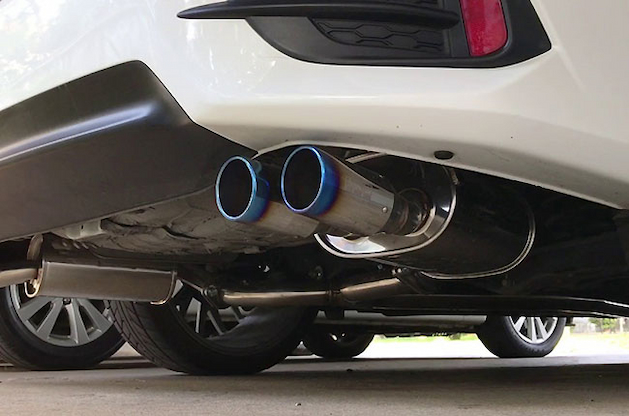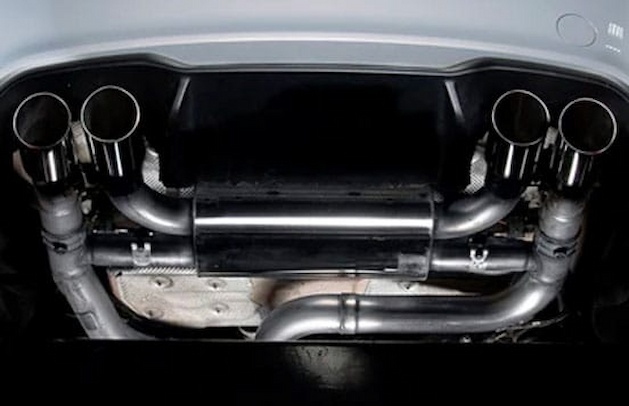Need more from your car without breaking the bank? Performance upgrades are a dime a dozen, but all serious tuning projects begin by optimising air and fuel ratios. Here, basic parts and systems, such as air intakes and matching exhausts, are the first to undergo a makeover. Beefed-up aftermarket versions offer improved builds, enhanced engine efficiency and inherently good looks, combining performance, durability, and aesthetics in value-packed components.
Why Upgrade From Your Factory Exhaust?
Car makers are known for cutting corners to keep prices down. Exhausts, unfortunately, are the parts that often bear the brunt, with mediocre materials and production methods that barely meet engine needs. Add to this strict emissions and noise regulations, and you’ll find exhausts that slither from the manifold to the tips in multiple bends and in thin, crush-bent piping made of mild steel. To keep prices down further, narrow (2″ and 2.5″) diameters impact proper flow, creating restrictive points and a buildup of exhaust backpressure. The final blow is taming soundwaves in restrictive muffler and resonator designs. Combined, these design decisions rob a considerable chunk of engine power.
By addressing the shortcomings of factory systems, well-designed aftermarket exhausts aim to maximise an engine’s performance. Key benefits include:
- Increased engine power and torque: Optimal airflow resulting from straighter and wider pipe layouts reduces restrictions and lets the engine breathe. By increasing exhaust velocity, well-built aftermarket exhaust systems improve engine efficiency, freeing up the engine for new intake air. Also, by lowering pressure and temperatures at the intake end (with hot gases concentrated in the exhaust piping), exhausts contribute to better burns that also increase power and torque. Full systems can add up to 10 per cent more power and deliver noticeable low-end torque for quicker acceleration and higher top speeds.
- Improved build and durability: A performance car exhaust is built around mandrel-bent, high-grade 304 or 409 stainless steel with higher heat and impact resistance. Also, builders utilise thicker pipe walls to counter leaks and punctures. This ensures heat is kept within the system and doesn’t radiate or damage adjacent parts. A considerable improvement is the material’s increased corrosion and stain resistance, meaning lower instances of rust and related damage.
- Better sound: Bigger, wider and straighter piping helps both exhaust velocity, as well as the sound gases produce as they exit the system. This verges on deep, throaty and rumbling, with fewer obstacles along the way. Changes here also include straight-through piping in parts like the catalytic converters and mufflers, all while meeting emissions and noise regulations.
- Customisation options and improved visuals: Change factory parts with pre-assembled axle-back, cat-back or header/turbo-back systems, or add new downpipes, collectors, mid-pipes, catalytic converters, tail pipes, mufflers, resonators and tips to existing factory exhausts. Modular, bolt-on, or welded designs help meet individual needs. Buyers can also experiment with layouts, such as X and H-pipes in the mid section, choose different muffler and resonator combos to fine-tune the sound and a range of shapes, materials and finishes in the tips.

Getting the Exhaust Your Car Deserves
Complete Systems
Axle-back exhausts are the most affordable among “complete” exhaust systems, with new mufflers, tailpipes and tips the main changes. Parts are assembled into pre-configured, ready-to-install systems. Choose an axle-back exhaust for a deeper and louder exhaust note, and improved materials over the aluminised steel commonly found in production cars. This has higher impact and corrosion resistance, and handles water and debris better.
For tangible power gains, go with the wider mid-pipes in cat-back systems. These help relieve backpressure, boosting engine efficiency. Additional benefits include reduced fuel use and a deeper, more refined exhaust sound.
For outright performance and in cars that will see serious tuning mods, go with header-back exhausts in naturally aspirated engines, and turbo-back systems in vehicles with forced induction. Revised header and downpipe designs draw spent gases out faster from the combustion chamber in what is known as exhaust scavenging. This then passes at higher velocities through high-flow cats and less restrictive DPF filters (in diesel engines). Full aftermarket exhausts belt out the most power, but also shed considerable weight, with 40-odd pounds in dual systems from a pair of cylinder banks.
Materials, Sizing and Fit
Stainless steel is key to durability and expected performance. However, for serious upgrades in performance and luxury vehicles, also look into the advantages of high-end options. Titanium is a durable metal with a high melting point and a natural oxide layer that protects it from rust. It’s also half the weight of steel. Nickel alloys, such as Inconel, Hastelloy, and Monel, also sell with high impact, fracture and heat resistance, but their higher density increases weight. Both materials are used in headers, downpipes, mid-pipes and muffler designs. For the tips, besides 304 or 409 treated stainless steel in a variety of finishes (brushed, polished, anodised, burnt-blue), consider high-modulus carbon fibre with a unique woven look and dark, high-contrast colours.
Sizing refers to pipe diameters. To reap the benefits mentioned above, consider going half an inch wider than the factory piping. The added space ensures proper flow, while keeping just enough backpressure to spool turbines. 3-inch designs are the most common, though some bigger V8 engines will benefit from 3.5″ pipes. Lastly, check that your new exhaust fits the car with minimal changes to the undercarriage (fits the factory recesses) and is supplied with corresponding hardware, including brackets and mounts to prevent vibrations.


